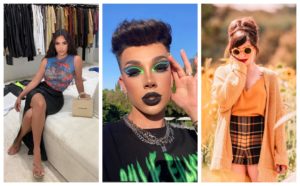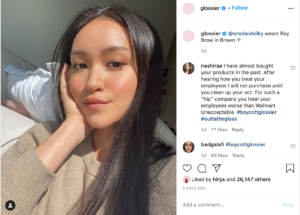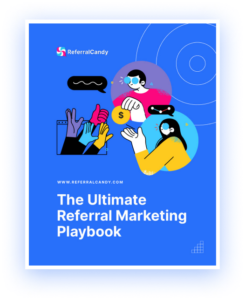Traditional media is dead. Long Live the Influencer. With many brands realizing the fledgeling hold of conventional media (i.e. newspapers and print magazines) on its audiences and the changing ways how people consume content, influencer marketing has etched its way into the mediascape and shows no signs of slowing down.
Influencer marketing is essentially engaging – either on a paid or organic basis – a content creator who has a substantial following on their social media platforms, most commonly Instagram and the newly minted Gen Z app TikTok. Usually, if the influencer is paid they would declare it in their postings with the relevant tags such as #sp, #ad, #spons as required. Otherwise, it’ll be entirely up to their discretion to post if it is organic.
Influencers are typically separated into six main categories, Mega, Macro, Micro and Advocates, Referrers and Loyalists. Putting faces to labels below:

Kim Kardashian (Mega), James Charles (Macro), KeikoLynn (Micro) – Source: Instagram
Advocates can span across the above three categories, but their profiles specifically promote a cause or lifestyle for example: vegan influencer Ellie Bullen. Referrers and Loyalists can be social media influencers or they can be people who are influential in the consumer’s life. These are people who spread the word or recommend your business to others in their lives, and their opinions are trusted.
Myke Motus (@mykemotus), a lifestyle micro-influencer with a following in Canada, USA, and Asia says of brand partnerships: “Paid collaboration is an alley for both brands and online personalities to earn the trust of the market in the fastest, cost-efficient and creatively relatable way.” Brands he has worked with include Seven Crash, Bang & Olufsen and Diptyque.
8 brands that nailed influencer partnerships
The best way to learn is by example! So here are eight brands who have taken influencer marketing to the next level.
1) Colourpop
Colourpop is consistently reposting influencer content on their Instagram page and collaborating with trending influencers for their own makeup lines with Colourpop. For example, Safiya Nygaard and Kathleen Lights. To keep their followers keen and cutting through the noise of the many beauty brands, they also have exclusive collaborations with popular cartoons such as Sailor Moon, Mulan and their very own Hasbro design.
2) Starbucks
Starbucks created its premium brand ‘Starbucks Reserve’ and opened its doors to the public in December 2018 in New York City. To create hype tastefully, Starbucks started a targeted campaign working with three NYC lifestyle micro-influencers to create a cohesive and nuanced set of promotional posts that lent credibility and finesse to the newly born roastery.
3) Gymshark
@gymshark @rybkatwinsofficial rockin’ our pastel collection🙌 which colour is your fave? #gymshark66
Youthful athleisure and sportswear line Gymshark pioneered its business into the arena of TikTok by engaging top TikTokers – the Rybka Twins – to plug their clothing alongside the trendy dance moves associated with the platform.
4) SodaStream
Jumping on the bandwagon of the Game of Thrones final season, SodaStream talked about the company’s benefits and revolutionary plans while incorporating “The Mountain” character from GOT. After taking a step away for their usual family-friendly engagements, the video has since garnered 50 million views and counting.
5) Vaseline
Last-minute shoppers rejoice! @Vaselinebrand Lip Therapy is now available in a stick and there is a flavor for everyone on your list. Pick up at @Walmart in time for the holidays! #ad #VaselineSoothingPower pic.twitter.com/xkt3V1q60C
— Garf (@g_kohls) December 9, 2019
Tried and tested household name Vaseline joins the influencer game by targeting micro and nano influencers to promote their seasonal chapsticks on Twitter. These smaller influencers typically have higher engagement rates due to the platform algorithm, there is also a lot more room for trial and error
6) Glossier

Relying on loyalists and referrers to get the word out, beauty brand Glossier utilises ‘regular women’ for honest testimony on the products’ effectiveness. At the moment, Glossier has anointed 11 women as official ambassadors with their landing pages on the website. These women get exposure by association and will in turn grow their online presence.
7) Ralph Lauren
@ralphlauren Life is about winning. 🏆 Show us how you’re #WinningRL and we’ll pick 3 champs
The brand’s #WinningRL campaign saw influencer Diana Silvers and asked consumers to participate in the discussion for a chance to win an official Polo Ralph Lauren US Open apparel. This challenge also enabled TikTokers to purchase items from an in-app store which helped increase the brand’s ROI.
8) Prada
AI Influencers? Say it isn’t so! But yes, it is a thing. Lil Miquela (@lilmiquela) a computer-generated influencer with 2.7 million followers was engaged by Prada to show off their Autumn 2018 collection. Content created ranged from animated GIFs, Instagram videos and virtual tours with her all dressed up in signature Prada pieces.
How do I engage an influencer for my business?
Ok, you’ve decided on the type of influencer you want to engage for your brand. Now what? It’s the usual fork in the road of “Do I hire an influencer agency?” or “Do I do it myself?”. In a previous article, I’ve spoken hiring an agency first to create a sturdy base before attempting to do it yourself, unless you have relevant experience in the field.
Hiring an influencer agency to manage your influencer marketing can enable your brand to leverage on their expertise and existing relationships, determine the right platforms for the best reach, and professional counsel on content boosting and access to consistent reports.
Generally speaking, reaching out to influencers on an organic basis is seen as more credible than paid sponsorship. However, with the right paid placements and profile – a sponsored post can also obtain a high success rate. Paid partnerships can either be monetary in nature or service/products in place of cash.
Mariah Johari, a communications and PR consultant who has worked with many influencers in Australasia says: “It is very important to establish the deliverables with the influencer from the get-go. Do give them clear instructions such as campaign messaging, direction and suggested angles for their shoot, deadlines, caption notes and reference materials from other sources. Although organic engagement is still more credible, influencers also prioritise paid projects and should give your brand more love on their page.”
“It is also important to note that influencers do reject paid campaigns if your brand does not align with their feed or values. If they have a contract with a direct competitor of your brand, they may also turn it down due to conflict of interest, so do have a few influencers on a list instead of just one,” she continues.
How do I measure effectiveness?
To gauge the effectiveness of an influencer, you’ll need to look at their engagement rates. For example, you’ve hired an influencer to push your new product and give them a special promo code for their followers. You will be able to track the success rate of the sponsored post based on the engagement levels ( stats are usually provided by the influencer if it is paid post), otherwise, a rough gauge can be taken based on the engagement rate of the entire account, this can be seen from free websites such as SocialBlade.
Depending on the demographics of the influencer which correlates to spending power, you may be able to see more direct conversions into sales – however, influencer work is predominantly for brand awareness and conversation on social media platforms about the brand. All in all, love’em or hate’em influencers can be a worthwhile investment for your brand when done correctly.
If you’re interested in boosting your word-of-mouth marketing strategy, check out ReferralCandy and InfluencerCandy!



